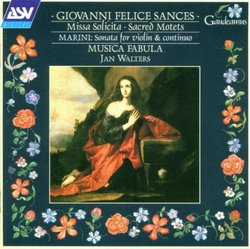| All Artists: Biagio Marini, Belinda Sykes, Adrian Chandler, Sarah Pillow, Paul Willenbrock, Musica Fabula, Wills Morgan Title: Giovanni Felices Sances: Missa Solicita / Sacred Motets / Biagio Marini: Fourth Sonata for Violin & Continuo - Musica Fabula Members Wishing: 0 Total Copies: 0 Label: Gaudeamus Release Date: 8/18/1998 Genre: Classical Styles: Opera & Classical Vocal, Chamber Music, Historical Periods, Baroque (c.1600-1750), Instruments, Strings, Symphonies Number of Discs: 1 SwapaCD Credits: 1 UPC: 743625018028 |
Search - Biagio Marini, Belinda Sykes, Adrian Chandler :: Giovanni Felices Sances: Missa Solicita / Sacred Motets / Biagio Marini: Fourth Sonata for Violin & Continuo - Musica Fabula
CD Details |
CD ReviewsThe Lop-sided Pearl Giordano Bruno | Wherever I am, I am. | 02/15/2010 (5 out of 5 stars) "Musicologists trace the etymology of the term "baroque" to Portuguese, to the words "perla baroca' meaning an a-symmetrical pearl. Such pearls were once scorned, then highly valued; such is human fashion. In any case, the term 'baroque' in cultural history was first applied to the flamboyant, melodramatic, excessively ornate architecture and sculpture of the 17th C, and from the visual arts the term spilled over into music. And it was appropriate, I think; in place of the highly symmetrical, dispassionate, philosophical music of the late Renaissance, composers of the 17th Century, especially in Italy, pursued an affect of passion unto hysteria, of ornamental virtuosity above all, and of a-symmetrical irregularity as an end in itself. By 1700, a certain amount of reaction had set in; the Arcadian Academy patrons who supported Handel in Rome wanted a more orderly sort of passion, and they got it. One might argue that the "real baroque" was limited to less than a century.
Giovanni Felice Sances (1600-1679) was the epitome of the 'Real Baroque", an almost exact contemporary of the architect/sculptor Gian Lorenzo Bernini (1598-1680), the cultural dictator of Counter-reformation Rome, the avatar of passionate excess. Have you ever visited Rome? Then you've seen Bernini's work. The famous "Three Fountains" in the Piazza Navona, for instance, are Bernini's, as is the flamboyant facade of the Jesuit Church of Jesus. For me personally, the baroque sensibility worked better by far in music than in sculpture or painting; I tolerate Bernini but I adore Italian baroque composers such as Carissimi, Caldara, and.... Giovanni Felice Sances! And yet, though Sances was trained in his homeland of Italy, he spent the best part of his career - 40 years! - in Vienna, and his influence was upon Austrian and German musical history. His last decade was spent as imperial Kapellmeister, a position later held by Fux. The music recorded on this CD exhibits the taste of Sances's Austrian employers and many of the 'expectations' of the Hapsburg religious establishment. The first motet, for instance (Improperium expectavit cor meum) was written for performance during Holy Week, when instruments were prohibited; it is therefore a 'polyphonic' piece in the conservative structure of the 'prima prattica', but it is also a shockingly bold excursion into chromatic dissonance. It was quite popular in Vienna, one discovers with some surprise; it held a place in the court repertoire until the middle of the 18th C. The Missa Solicita was probably composed in the 1630s or 1640s; the title basically means 'a mass in troubled times'. Even in the 17th C, such a musical setting of the Mass was only performed as such, that is, as part of a real service of the mass, with a real priest in a real church; if there were listeners, they were present first of all as a congregation. Such a service included the Ordinaries (Kyrie, Gloria, Credo, Sanctus, Agnus Dei) with their invariable texts, always separated by the Propers -- the texts of scripture specified in the liturgical calendar for the day of the service -- and the various 'actions of grace' by the clergy. Those Propers were originally sung as plainchant, and that's why many modern concert/ recording performances of polyphonic masses include chant, but from the 15th C on, it became common to substitute "motets' for the Propers. By Sances's era, it was also acceptable to substitute instrumental sonatas, or simply to insert instrumental interludes into a celebration of the Mass. The Missa Solicita recorded here includes nine litany/motets by Sances and a lengthy instrumental sonata by another Italian composer, Biagio Marini (1587-1663). Sances was a fine composer, I might even say a major composer of his time and place, not just another 'rediscovery' to keep the HIP ensembles busy. His style is hyper-baroque, as excited in affect as a Bernini sculpture of ecstasy. It requires extreme vocal agility, over a huge tessitura. Most of the singing is soloistic and operatic, supported by 'basso continuo' theorbo and/or harp. The ensemble Musica Fabula brings ample resources to this recording: twelve highly skilled singers to choose from, plus violins, gamba, harp, guitars, theorbo, and organ. And what does it all sound like? Well, above all, it's utterly beautiful. Despite its flamboyant ornamentation, it has the serene melodic order of Monteverdi's operas. In fact, it sounds a great deal like Monteverdi, which shouldn't be so surprising since Sances was at the height of his career at the same time that the long-lived Monteverdi was composing his opera Poppea. I can promise, if you enjoy Monteverdi, you'll be thrilled to discover Sances as perhaps his most passionate 'baroque' successor." |


 Track Listings (17) - Disc #1
Track Listings (17) - Disc #1